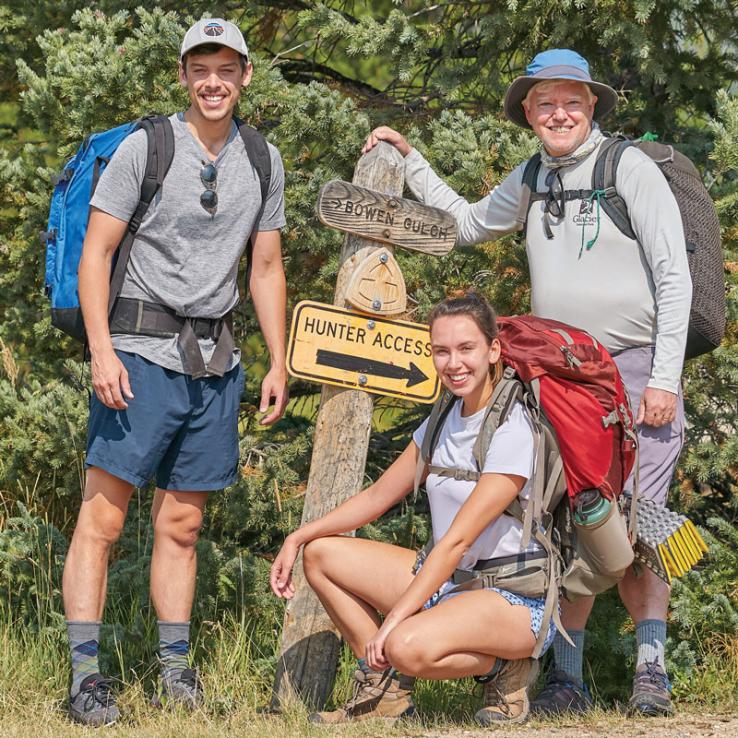
The Trailblazer: One Man’s Journey to Achieve the Triple Crown of Hiking
By Caroline Benner ’98
(Published in the Reunions Guide, May/June 2018)
In 2002, Bill Plonk ’83 hiked all 2,190 miles of the Appalachian Trail. In 2012, he took on the 2,650-mile Pacific Crest Trail. In 2017, Plonk embarked on his most ambitious hike yet — the approximately 2,500-mile Continental Divide Trail. Completing all three hikes is considered the Triple Crown of hiking, and only about 330 others have been recognized for this feat that takes hikers across a total of 22 states.
The Appalachian Trail (AT) fascinated Plonk as a boy growing up in Virginia. Plonk’s father attempted to walk across North Carolina on the AT in the 1940s, an expedition that ended early due to injury. The road beside the Plonks’ family cabin in Linden, Va., merges with the AT for a stretch, and Plonk and his father would walk the trail, wondering about the intrepid adventurers who took on the whole thing.
As Plonk, a geriatrician and palliative care specialist in North Carolina, pursued his professional goals after college, the lure of the AT faded. But in the early 1990s, a series of unfortunate turns would change that. In 1994, Plonk was diagnosed with testicular cancer; around the same time, he was compelled to sell his small, rural medical practice to a hospital. Once he overcame cancer, he found himself a disaffected employee of a hospital, a daily witness to “how [medicine] has become a business instead of a vocation, profession, or calling,” Plonk says.
Then in 1998, an acquaintance gave Plonk A Walk in the Woods, Bill Bryson’s account of his AT hike, and very quickly, Plonk’s old fascination returned. Cancer had “pulled off the blinders and challenged all my assumptions. That experience ... convinced me the future was uncertain and that I needed to eat dessert first,” he says.
He prepared for the AT by researching: He learned that even cutting off the handle of his toothbrush would lighten his backpack; he studied maps, read journals of previous hikers, and began dehydrating food.
Then he quit his job. “I needed some big adventure to regain my identity and self-respect,” Plonk says.
After a few test walks with a loaded pack, in February 2002, he set out.
Soon, he developed a hiking routine: He woke with the sun, ate oatmeal or a granola bar, and hiked until 10 a.m. Lunches were a flour tortilla sandwich, with cheese and salami as popular fillers. After a break at 4 p.m., he’d hike until dark or until he reached the day’s destination, where he’d set up his tent and boil water on his backpacking stove to reconstitute a dehydrated meal.
Within a few weeks, he was hiking 20 miles per day, up and down steep rocky hills through the leafy forests of the East Coast. Sometimes he would encounter fellow hikers from whom he heard stories about everything from stock investing to drug rehab.
After six months of fighting to stay warm and dry, Plonk finished the AT, hungry, bone tired, but also “fully alive and self-actualized.
“The day I climbed Katahdin [the mountain at the end of the trail] was one of the top five days of my life. I’d survived cancer, set an ambitious goal, and finished something I had always wanted to do.”
“What has the trail taught me? Experience means more than stuff. Success is defined not by how much one has but by how little one needs. Less is more — in life and medicine.”
— Bill Plonk ’83
Plonk returned to his regular life, several pounds lighter, to begin a new job in Virginia. But the memories of the trail lingered. So much so that 10 years later, on a whim, he decided to hike the Pacific Crest Trail (PCT), which runs through California, Oregon, and Washington.
“I was going to be halfway across the country interviewing [for a new job in Missouri] and [figured I] could just keep going.” His preparation amounted to shipping his AT gear to a town the trail crosses 109 miles north of the trail’s start at the Mexican border in Campo, Calif. He made do with the little gear he had with him for the first 109 miles of hiking. The PCT is considered a more mentally demanding trail than the AT. It traverses 100-degree deserts; snow-covered, sometimes-impassible mountain ranges; and its northernmost forests are regularly soaked by cold rain. By mile 1,378, in Old Station, Calif., Plonk ran out of morale. “I was lonely and tired,” he says. Plonk told himself he’d take a week off to visit his family. But his return was delayed another several days by giardia, a parasite that besets its victims with weeks of digestive horrors. “I almost didn’t go back, but I knew it was now or never. Also, I hate quitting.”
The Continental Divide Trail (CDT), Plonk’s most recent hike, has an unofficial motto: “Embrace the brutality.” It is a much more primitive hike than the other two trails, and Plonk hiked 2,500 miles of it over 132 days. He had to skip 67 miles in northern Colorado due to an early winter storm and an ankle injury, but he intends to complete this section (and the Triple Crown) this summer with his son John ’15 and daughter Natalie ’18.
A long hike is a chance “to turn back the clock, to feel physically strong, emotionally focused,” he says.
“What has the trail taught me? Experience means more than stuff. Success is defined not by how much one has but by how little one needs. Less is more — in life and medicine.”
